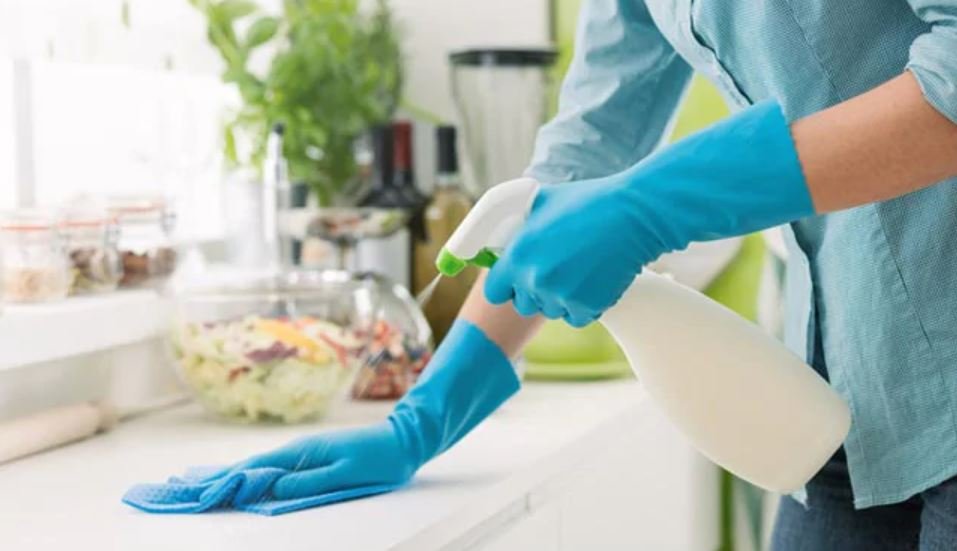Kitchen
Spick, Span, Sanitized: 8 Tips for Achieving a Germ-Free Kitchen

Regardless of how squeaky clean your kitchen may look, chances are germs are hiding in unsuspecting places. Unfortunately, your cooking quarters are likely one of the most bacteria-ridden spaces in your home, with your hands being the number one super spreader. Additionally, food products harbor some pretty nasty bacteria, like salmonella and E. coli, that expand and contaminate quickly if not cleaned properly. While it may seem like you’re playing a losing game when attempting to sanitize your kitchen, there are ways to increase your chances of a germ-free kitchen.
If you’re sick of wiping down surfaces and mopping up spills to no avail, read on for eight cleaning tips to keep your kitchen spic and span.
[lwptoc]
Ditch the kitchen sponge
The first step in avoiding hazardous kitchen pathogens is ditching your well-loved sponge for a high-quality dishwashing unit. There is a common misconception that hand-washing your dishware not only offers a more thorough clean but is also better for the environment. However, as dishwasher appliances have advanced over time, it’s become apparent that those seeking a thoroughly sanitized set of dishes should rely on a machine, not a bacteria-ridden sponge. Unfortunately, most sponges have high levels of microbes, which means every pass you make on your dishware could be spreading harmful pathogens.
Though some are accustomed to handwashing, a dishwasher can ultimately save you time and money. Just make sure you purchase your unit from reputable home retailers like Goedeker’s to ensure your dishwasher is high-quality and long-lasting.
Wash your hands frequently
One way to reduce unwanted germ spreading in your kitchen is by washing your hands frequently. Though it may seem obvious, most people severely underestimate how fast germs spread via hand-to-surface contact, going prolonged periods between washes. Make sure you’re scrubbing thoroughly before and after handling food, especially raw meats, and after you’ve finished your meal. That way, you can significantly reduce the risk of spreading harmful bacteria and viruses across your kitchen or contaminating your food.
Declutter countertops
The more surfaces germs have available to cling to, the more difficult it is to keep bacteria at bay, which is why decluttering your countertops can reduce microbial spread. People often forget to wipe down items like coffee pots, stand mixers, and oil canisters, leading to a smorgasbord of hazardous bacteria waiting for the perfect opportunity to infect. By keeping appliances and other kitchen clutter stored away, you can bypass nasty build-ups.
If you have limited closed storage and utilize every inch of your counter space out of necessity, make sure you’re wiping down each surface frequently, taking extra care to remove and cleanse items.
Wash out your sink regularly
One of the dirtiest areas in your kitchen is the sink, which collects residual food bits and bacteria from your dishware. Chances are, leftover bits and bobs are building up in your basin, creating a cluster of potentially dangerous pathogens and germs ready to cling to the nearest reaching hand. To ensure your sink remains germ-free and sparkling at all times, run the disposal frequently, clear out any debris, and use a potent disinfectant to sanitize. That way, you can use your beautiful basin without worrying about microscopic intruders spreading quickly throughout your kitchen space.
Clean up spills immediately
Though it’s tempting to leave spills now and again when you’re in a hurry or feeling unmotivated, immediately wiping up food mess can significantly reduce germ spread. Any splashing, drippage, or residue can build up over time, adding fire to the bacterial flame. Additionally, accumulated messes can be challenging to scrape and scrub, leaving you with a more considerable clean-up than you’d anticipated.
Sanitize your cutting boards
Often, people who cook frequently overlook proper cleaning techniques when scrubbing down their cutting boards. Though you may think a simple rinse with warm water will do the job, germs and bacteria fester on chopping blocks left unsanitized for long periods. Additionally, consider purchasing a separate board for poultry to avoid cross-contamination with vegetables and fruits. That way, you can use more gentle products on veggie boards and save the bleach-based solution for raw meat remnants.
Swap out dirty dish towels
Although it can be easy to lose track of how long you’ve been dawning the same dish towel, you’re better safe than sorry grabbing a fresh and clean rag when in doubt. While you may worry about overloading your laundry with hoards of hand towels and dishcloths, bacteria accumulate quickly on damp kitchen rags. Instead of prolonging every use, change kitchen towels frequently, depending on how often you’re using them to wipe down surfaces.
In addition, it’s wise to keep drying towels, hand cloths, and surface cleaning rags separate from each other to avoid cross-contamination. That way, you can get more use out of drying-specific towels while changing grimy, damp cleaning cloths daily.
Wrapping up
Achieving a spotless kitchen is easier said than done, especially with susceptible bacteria building up around every nook and cranny. However, with the proper tools, techniques, and habits, you can ensure your kitchen remains germ-free and ready for action. By wiping surfaces with potent cleaners regularly, sanitizing your cutting boards, and washing your hands before and after kitchen ventures, you can keep harmful bacteria to a minimum.
-

 Celebrity4 weeks ago
Celebrity4 weeks agoIs YNW Melly Out Of Jail? What Is The YNW Melly Release Date, Career, Early Life, And More
-

 Sports4 weeks ago
Sports4 weeks agoMore Than Just a Game: How College Sports Can Shape Your Future
-

 Tech3 weeks ago
Tech3 weeks agoAI Software: Transforming the Future of Technology
-

 Tech3 weeks ago
Tech3 weeks agoAll About Com. Dti. Folder Launcher: Features, Benefits, Tips, And More













